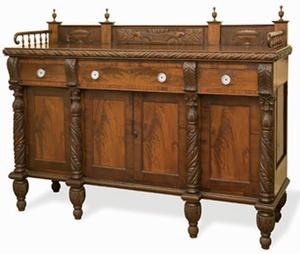

This mahogany sideboard (c. 1820s) is part of the exhibit, "A Century of Furniture: The Rose Cabinet Shops," at William King Regional Arts Center in Abingdon, Va.
ABINGDON, Va. -- "The Rose Cabinet Shops: A Century of Furniture" may be seen through January 4, 2009, at the William King Regional Arts Center in Abingdon. The exhibit features approximately 20 pieces of furniture made by the Rose family. John Erhart Rose (c. 1767-1860) apprenticed in Philadelphia, owned a shop in Abingdon, and also worked in Knoxville, Tenn. His sons continued making furniture in Abingdon in the second half of the 19th century. The family's furniture spanned more than a century, creating and modifying styles such as Federal, Empire and Gothic Revival.
Of the research for this exhibition, Betsy White, director of William King Regional Arts Center, says, "We made so many friends throughout our treasure hunt, so many generous people who helped to tell this story of the Rose family of cabinetmakers in this exhibition, of which 99% has never been shown publicly."
In the introduction to the exhibition guide, White explains:
It is not often that a community has the pleasure of identifying a significant piece of its cultural history and placing it within the broader context of American heritage. Such is the story of the Rose cabinet shops. They were begun by the father, a Philadelphia-trained cabinetmaker whose somewhat rambling ways took him from Pennsylvania to Abingdon to Knoxville and back again, and carried on by his sons, where Abingdon was the site of their life's work.
Our portrait of the Rose cabinetmakers began more than 10 years ago and only took shape a year or so ago when three sets of parallel research came together quite serendipitously. About 1995, early days in the Cultural Heritage Project research, I noted the existence of cabinetmaker, John E. Rose, in Abingdon's 1810 census records and on one small notation in the records of the Museum of Early Southern Decorative Arts (MESDA) in Winston-Salem, NC, but no examples of his furniture. About John's sons, there was ready information and, indeed, known furniture, as they operated two shops in Abingdon from mid-19th through to the 20th century. I contacted my colleague, Sumpter Priddy III, a well-known scholar of southern furniture and its related research. He sent me information about an 18th century Pennsylvania clockmaker, Daniel Rose, who didn't, however, appear to have a son named John. It seemed a dead end.
Much later, our book, Great Road Style: The Decorative Arts of Southwest Virginia & Northeast Tennessee, was published in 2006 with a reference to John Rose next to a chest of drawers by his sons. Soon afterwards, Mike Bell, the Curator of Furniture at the Tennessee State Museum, called me to say that he had a signed piece of John's work and was surprised to find a connection to Abingdon. With some haste, I was in Nashville standing with Mike before an elaborately carved and highly styled secretary purchased years before by another colleague, Jim Kelly, just prior to his move to the Virginia Historical Society, Richmond. Pretty as it was, this secretary did not speak of Southwest Virginia to me.
Puzzled, I drove home thinking about carved furniture. Next to none had surfaced during our fieldwork, and then I remembered Sumpter having sent me a photograph of a carved sideboard and asking if it looked "local." It hadn't, and I had put it aside, but thankfully had not discarded it. Arriving back in Abingdon, I found the photograph, dated 1999, and much to my surprised delight, saw an identical urn, fruit basket and eagle heads as those carved on the TSM's secretary.
My notes from Sumpter indicated a Russell County history, and the next step in the chain of serendipity cinched the deal. Our good friend, Lee Stuart Cochran, a native of Russell County, happened to be in our galleries about a week later, and I showed her the photograph of the sideboard. Her immediate response was, "That's mine!" Mystery solved. Her sideboard, which she has since donated to the University of Virginia, had direct provenance to Abingdon, confirming that the TSM's John Rose was also Abingdon's John Rose. Things mushroomed from there, and even our genealogical quest suddenly took flight. Building on previous research and current discoveries by Susan Shames, our newest helpmate, plus one particular piece of good sleuthing by Mike Bell, we nailed down John Rose's parentage. It was the clockmaker, Daniel Rose -- after all.
With the pieces of our puzzle now snugly interlocked, our exhibition was moved from concept to the confirmed schedule. Perhaps it was all due to serendipity: Jim Kelly's savvy purchase, my saved photograph, Sumpter's tireless research, and Mike Bell's interest that prompted a phone call to me. Of course, it was more than that. The scholarship, dedicated research goals, and collegial collaboration were really what made this groundbreaking project come to fruition.
READ November A! Magazine's cover story:
-- Betsy White & William King Regional Arts Center